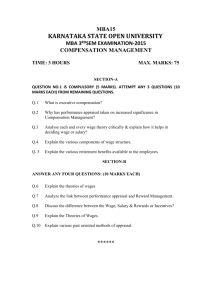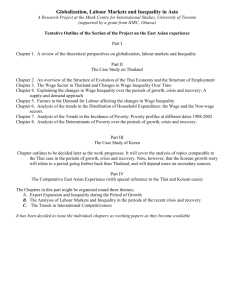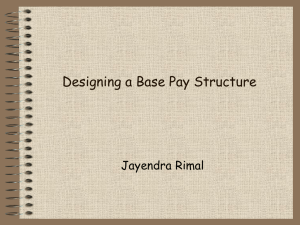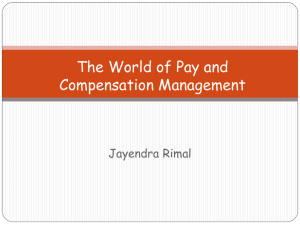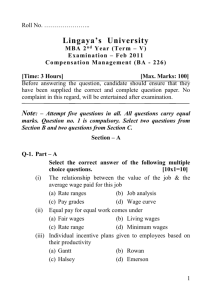Productivity Growth and the Distribution of Income
advertisement
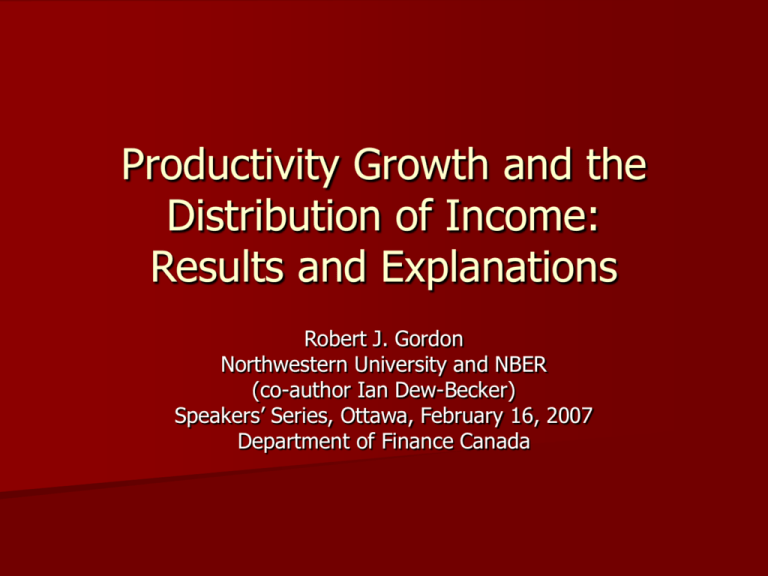
Productivity Growth and the Distribution of Income: Results and Explanations Robert J. Gordon Northwestern University and NBER (co-author Ian Dew-Becker) Speakers’ Series, Ottawa, February 16, 2007 Department of Finance Canada Ian in SF, you can’t see “MV=PY” 2 Everyone Knows that US Inequality has increased, what is new here? For decades, U. S. data on median family income and median real wages show virtually no growth But U. S. productivity growth has exploded since 1995 and especially during 2001-04. Where did the extra productivity growth go? If the median wage earner didn’t get it, who got it? 3 The New Elements in Our Data Analysis and Interpretation In part this presentation is a sequel to our 2005 BPEA paper, where we were the first to – Link NIPA and IRS data – Unravel the puzzles of stable labor’s share, rising mean wage income, and stagnant median wage income. Our explanation moves beyond some of the literature by – Distinguishing between causes at the bottom (0-90) and at the top (90-99.99) – At the top, trying to sort out explanations involving SBTC, Superstars, and CEO pay 4 Productivity Growth vs. Median Real Wages and Median Real Household Income Labor’s share of domestic income was basically flat between 1997 and 2005. Implies CPH growth = LP growth But… – Median wages grew at half the rate of productivity between 1995 and 2003 – Real median family income fell for five straight years between 1999 and 2004, before rising in 2005. 2005 was 2.8 percent below 1999 and only 16 percent above 1973. – Yet 1999-2004 was a period of buoyant productivity growth The conflict between mean growth and median growth poses a basic question: is it a measurement issue or an income distribution issue? 5 Our Headline Result in 2005 Over the period 1966-2001 only the top 10 percent of the income distribution had real compensation growth equal to or above the rate of economy-wide productivity growth Today’s presentation – – – – Reviews our basic 2005 results Updates macro data on productivity trends and labor’s share Updates Tables 1 and 2 of the 2005 paper Provides a more complete review of explanations of increased US inequality at the bottom (0-90) and at the top (90-99.99) – Adds a preliminary review of international data 6 The Enormous Discrepancy Between Productivity Growth and Real Wage Growth The basic puzzle: as of July 2005, NFPB productivity growth 2001:Q1-2005:Q1 was 3.89 and real AHE only grew at 0.49. How can we explain this enormous gap? Was there a massive shrinkage of labor’s share? Explanation #1: data revisions. 2001-05 productivity growth was reduced from 3.89% to 3.44%. Now in February 2007 that same number is 3.38%. Extended to 2006:Q4 is 2.99%. Explanation #2: trend vs. actual. The trend barely reached 3.0 percent. Explanation #3: Full economy productivity 0.5% slower than NFPB. Further Explanations – Alternative Wage Indexes – Alternative Deflators 7 8-quarter Actual NFPB Output per Hour vs. the Average Trend (through 2006:Q4) 6 5 4 3 2 1 0 -1 -2 1955 1960 1965 1970 1975 1980 1985 1990 1995 2000 8 2005 Productivity Growth in the Total and NFPB Economy, 1950-2005 9 The Macro Data Analysis Involving Productivity and Compensation Growth, Table 1 This provides data on the entire economy, not just the NFPB sector. The evolution of productivity growth compared to compensation growth differs greatly by specific historical interval 2001-06 retraces the steps of 1997-2001 10 Two Concepts of Labor’s Share Two Concepts – Straightforward share of NIPA employee compensation in net domestic factor income – Add in labor’s part of business proprietors’ income Both concepts are expressed as a percentage not of GDP but of domestic income at factor cost (excludes depreciation and indirect bus taxes) What to notice – Up-down cycle 1997-2006 repeats 1987-97 – Share was higher in 70s – Comprehensive concept no change since 50’s 11 What has Happened to Labor’s Share? 80 Compensation w ith labor component of Proprietor's income 75 70 Compensation 65 60 1950 1955 1960 1965 1970 1975 1980 1985 1990 1995 2000 122005 Lack of Connection between Labor’s Share and Inequality Incomes were much more equal in 1950s but labor’s share was the same (or lower for the narrow measure) Much of the rise in inequality > 90th percentile occurs in labor income, not capital income The main story is increased skewness within labor income, not a shift from labor to capital income 13 What is Happening with the Nonlabor Share? FIgure 2b. NIPA Nonlabor Income Share by Component, 1950-2005 40 35 Percent/100 30 25 Corporate Profits 20 Interest 15 10 Proprietor's Income Government Enterprises and Transfer Payments 5 Rent 0 1950 1955 1960 1965 1970 1975 1980 1985 1990 1995 2000 14 2005 Some Things to Think About Apparent regime change around 1966 – No good explanation so far – Our macro data analysis helps by linking labor’s share increase in late 1960s to the productivity growth slowdown Share is similar now to 1997. Smoothly varied in small range for past 30 years So what’s all the fuss about? It’s not that capital is gaining relative to labor, it’s who is getting labor’s share 15 A Proviso: The Dramatic New Work on Intangible Capital The Authors: Carol Corrado, Charles Hulten, and Dan Sichel Their Basic Result: About $1 Billion Dollars in “Intangible Capital Investment” has been omitted from U. S. National Accounts On the Income Side, this is all unmeasured corporate retained earnings Implication: Decline in Labor’s Share How Much do they Exaggerate its Importance? 16 The Inconsistent Wage Indexes, see Table 2 CPH, ECI, and AHE all tell different stories – AHE only covers production/non-supervisory ECI is smoother than CPH, but not linked to NIPA data Abraham et al. (1999) argue that most of the AHE-CPH gap is due to AHE’s sample – Production workers not only make less, but have less growth – AHE vs. compensation reflects the difference between median growth and mean growth 17 Our Micro Research: Linking the IRS and NIPA Data To whom do the benefits of productivity growth accrue? Our contribution is a measurement of income inequality with a direct comparison to productivity growth Thus we focus on which percentiles of the income distribution received real income gains We started noting that medians grew much slower than averages. Here we uncover the nuts and bolts of why this happened 18 Differences with Piketty-Saez on U. S. We have in common: reliance on tax data Their approach: look only at top 10% but over a long period (U. S. starting in 1913, France starting in 1901) – Their denominator (total income) is not from IRS but from national accounts We look at entire tax distribution from zero to 99.99 (not just 90-99.99) – Our denominator is total reported tax income, not national accounts (but we compare the two) At the end: comments on US vs. Canada, UK, France, and Japan 19 Sources of Income Inequality: IRS Microfile Data Cross-sectional data for 1966-2001 – – – – Heavily oversamples rich Allows analysis of top .1% or .01% 100-200,000 returns per year 3,000+ returns in top 0.01 percentile out of 13,000 total filers This study is based on roughly 5 million data points, a few more than the typical time series quarterly postwar data analysis! The IRS micro data file provides every type of income on tax returns – wages & salaries, rent, interest, dividends, business income, pensions ~90-95% of tax units file each year 20 Advantages of IRS Data over CE/CPS Data Used by Others Other papers based on CE/CPS data understate increase in inequality – We find half of increase in inequality represented by 90/10 ratio, the other half is within 90-99.99 CE/CPS data are top-coded, e.g., $35,000+ in 1972-73 Recall bias may vary with income IRS data are linked to actual records, W-2s and 1099’s What do we add? – Adjusting for non-filers – Eliminating negative nonlabor income – Adjusting IRS income for fringe benefits and changing hours 21 Comparison of IRS 90/10 to CPS from Autor-Kearney-Katz 3.4 2.9 Natural Log IRS Data 2.4 1.9 March CPS Data 1.4 Morg Data 0.9 1966 1971 1976 1981 1986 1991 1996 2001 22 Increased Skewness Above 90 is Missed by CPS Studies 1.4 1.2 Index, LN=0 in 1973 1 0.8 99.9/10 0.6 99/10 0.4 0.2 90/10 0 -0.2 1966 1971 1976 1981 1986 1991 1996 2001 23 Shares of New W&S, 1997-2001 0-20 1.9% 99.9-100 7.7% 20-50 10.8% 99-99.9 16.2% 50-80 23.4% 95-99 14.3% 90-95 11.0% 80-90 14.8% 24 What About Productivity? Adjust W&S upwards as wages take smaller share of compensation (~0.4%) – No assumption about level of W&S/Comp, just that change is same for everyone Add +0.22% for change in hours per tax unit – Assume changes in hours affect all equally Full economy LP averaged 1.54%, comp/GDP rose from 56% to 59%. Comp should follow LP 25 Almost Nobody Keeps Up The headline result: only the top 10% have experienced adjusted real income gains equal to or faster than productivity growth 90th percentile grows at 1.77%, 95th at 2.06% Everybody else slower than 1.54% Productivity growth has not raised median wages – adjusted growth of median is only 0.9% Could people be moving up across percentiles enough to account for this? 26 Adjusted Growth Rates Adjusted Percentiles Year 20 50 80 90 1966 1972 1979 1987 1997 2001 7,242 8,554 8,916 8,353 8,496 9,335 23,667 27,059 26,402 26,562 26,436 28,559 42,127 49,960 53,717 57,064 58,549 63,715 52,683 63,817 69,531 76,457 82,285 90,473 63,367 77,094 84,790 96,591 108,012 120,630 99,872 120,862 137,918 169,973 215,039 239,982 220,653 270,320 342,009 517,644 692,955 806,157 Percent Change Average Annual Growth Rate Hours Adjusted Growth 28.9 0.73 0.95 20.7 0.54 0.76 51.2 1.18 1.40 71.7 1.55 1.77 90.4 1.84 2.06 140.3 2.50 2.72 265.4 3.70 3.92 Years '66-'72 '72-'79 '79-'87 '87-'97 '97-'01 Average 95 99 99.9 Gap Between Productivity and Hours-Adjusted Growth 20 50 80 90 95 1.89 1.35 1.96 2.31 2.38 -0.37 -1.32 0.07 0.26 0.39 -2.45 -1.56 -0.88 -0.45 0.00 -1.39 -1.61 -1.30 -0.83 -0.44 0.75 0.33 0.51 0.77 1.16 -0.62 -0.81 -0.17 0.20 0.49 Percent Wage Share of Compensation 90.5 88.1 83.7 82.6 83.1 83.2 99 2.29 0.92 0.98 0.79 1.14 1.15 99.9 2.50 2.39 3.55 1.36 2.18 27 2.35 Labor vs. Nonlabor vs. Total Income (Fig 9 in paper) Figure 12. Share of Top 10 Percent in Increase of Real Income, $2000, Selected Intervals, 1966-2001 70 60 Percent 50 Labor Income 40 Nonlabor Income 30 Total Income 20 10 0 28 1966-79 1979-97 1997-2001 1966-2001 Measurement Issues In 2005 we assumed – The change in benefits was the same as the change in wages in each income quantile – The change in hours of work were flat across the income distribution By limiting our analysis to changes, we did not need to make an assumption about the level relationship between wages and either benefits or hours Benefits increased as a share of compensation, from 5 percent in 1952 to 18 percent in 1985. But flat at 18 percent since 1985. – Thus a changing share of benefits to wage and salary income is not an issue in analyzing the increased inequality from 1985 to 2005 29 How Large is the Bias in our 2005 Analysis of Changes? Pierce (1999) showed that total comp grew slightly faster than wages at the middle and slower in the tails. Compared to our results in his period (1982-96) total comp at the middle grows 0.2 points faster per year, at the top and bottom 0.4 points slower. No bias in the growth of the 90-10 ratio Limitation: Pierce’s short sample period 30 Levels vs. Growth Rates of Hours by Income Quantile Hours rise with income, as we would expect. In 2001: – Tax units in 0-20 worked 850 hours per year – Tax units in 90-100 worked 3850 hours per year But we only need information on growth rates What has happened to growth rates of hours by income quantile? 31 Growth in comp per hour With and without hours adjustment The hours adjustment makes little difference except at the bottom where hours increased Thus true compensation per hour in the 0-20 quantile fell much more in 1979-97 and rose much less 1997-2001 than in the unadjusted IRS data Overall, the gap in comp per hour growth rates is slightly smaller between the top and middle, and substantially larger between the middle and bottom 32 Original 2005 and Now-corrected AAGR of Compensation per Hour 7 6 5 4 3 CPS Hours Our 2005 2 1 0 0-20 20-50 50-80 80-90 90-95 95-99 99-99.9 99.9-100 -1 -2 33 Evidence on Income Mobility While inequality was increasing, there was no change in mobility (Bradbury-Katz, decade-long transitions within quintiles) – About 50% in penthouse are still there one decade later, same for basement – About 3% make it from basement to penthouse in one decade and vice versa – Lots of churning between 20 and 80 percentiles Bottom Line: Increased inequality has not been offset by increased mobility Opulence of penthouse has increased relative to basement 34 Causes of Increased Inequality: Current Debate Based on CPS Common Focus on Skill-Biased Technical Change (SBTC) to Explain 90/50 or 90/10 Since supply of college graduates has increased, SBTC says that demand must have increased more than supply Focus on Timing (1980s vs. more gradual process culminating in 1990s) 35 Puzzles SBTC Doesn’t Explain – 1989-97 real compensation of CEOs up by 100 percent – Real compensation jobs related to computer science increased only 4.8 percent – Real compensation of engineers declined 1.4 percent – Fully half (49%) of income gains in the occupational group “managers” – Almost none in occupational groups related to computers Why no increase of CEO ratio to average worker in Europe, just in U. S.? 36 Income Inequality below 90th Percentile Many articles and hypotheses focus on the timing of changes in the 90-50 and 50-10 ratios We had previously looked only at data on men and women combined But the time path for men and women is quite different, and here we present ratios from the latest CPS data (EPI web site) 37 Ratios 1973-2005 for Men 50 CPS Ratios for Men Only 40 30 90-10 20 90-50 10 50-10 0 -10 1973 1978 1983 1988 1993 1998 38 2003 Ratios 1973-2005 for Women 50 CPS Ratios for Women Only 40 30 All5010 20 All9050 All9010 10 0 10 1973 1978 1983 1988 1993 1998 2003 39 Organizing Principle for 90-10 Ratio: Reversal of the Great Compression Elements of the great compression of the income distribution in 1940-70: rise of unions, disappearance of imports and immigration Reversal: decline of unions, rise of imports and immigration Extra elements: equalizing influence of high school educ 1910-40 and min wage 40 The Role of Deunionization Everyone agrees it mainly affects men Main source is Card-Lemieux-Riddell Main conclusions: – Union wage distribution compressed – Small effect, just for males, maybe 14 percent of growth in variance of male wages 19732001 – SOWA 2006-07 has similar conclusions in a different metric 41 Second Aspect of Great Compression: Imports Trade, Imports, Job Displacement SOWA imply job losses across the income distribution – No real impact on the income distribution – Perhaps slightly more job losses at the bottom Trade has bigger impact on manufacturing employment; raises inequality if lost mfg jobs are above average wages 42 Third Aspect of Great Compression: Immigration Fact: Since 1970 triple the flow of immigrants as ratio of population and share of foreign-born workers in the labor force Borjas-Katz reduced form approach – Lower real wages of domestic workers by 3% 1980-2000 – Loss reached 9 percent for domestic workers without a HS degree 43 Challenge to Borjas-Katz from Ottaviano and Peri (2006) Replace Partial Equilibrium by General Equilibrium When Immigrants arrive, they stimulate capital investment Substitution is not general, immigrants compete with each other – Implication: New immigration drives down wages of existing foreign-born residents Thus we may have been asking the wrong question, not about the impact on native Americans but on the wages and skills of the entire population including the immigrants themselves 44 Minimum Wage Circumstantial Evidence Minimum wage hits women harder than men 50-10 ratio for women increased much more than for men and increased permanently It is hard to think of another convincing hypothesis than the influence of the minimum wage on the 50-10 ratio for women 45 Skill-biased Technical Change The gradual increase in 90-50 for both men and women lends plausibility to this hypothesis Our paper disputes some anti-SBTC arguments that are based on timing We endorse Autor-Katz-Kearney in broadening the concept of SBTC to encompass five groups, “nonroutine interactive” down to “routine manual” Reason for skepticism: occupational group data show low wage increases for engineers and computer experts, fast for “managers” 46 Increased Inequality at the Top, 99.99 vs. 90.0 percentile Previous distinctions (Kaplan-Rauh): trade theories (Hecksher-Ohlin) increasing returns to generalists (A-K-K) stealing theories (Bebchuk et al) social norms (Piketty-Saez) greater scale (Gabaix and Landier) SBTC (Katz and Murphy) Superstars (Rosen) 47 In this context, our 2005 paper introduced the Superstar vs. CEO distinction Our critics of 2005 said “superstars account for too little” but we explicitly included – Entertainment stars – Sports stars – Lawyers – By implication textbook authors, painters, musicians 48 Inequality at the Top: Superstars and CEOs Sherwin Rosen on the “Economics of Superstars” – Steep earnings-talent gradient at the top – “Hearing a succession of mediocre singers does not add up to a single outstanding performance” Earnings premium of superstars depends on the size of the audience – Magnification through technical change: phonograph, radio, television, cable television, CDs 49 Critique: There Aren’t Enough Superstars Entry level to IRS 99.99 percentile in 2001 was $3.2 million – 99.99 percentile accounted for $83 billion Forbes magazine “celebrity 100” – Total is $3.1 billion, average $31 million – Many more celebrities not included 50 The New “Census” of Sports Stars 2820 athletes in major league baseball, basketball, football Total income $7 billion, or $2.48 million each Time series on baseball back to 1988 – Average increased from $354,000 to $2.1 million – Inflation adjusted increase 8.9 percent compared to 6.0 percent for top 99.99 51 Broadening the Concept of a Super-star Superstars include top-paid lawyers, doctors, even economists who refuse to leave Harvard when offered megabucks to go to Columbia A few economists make millions by writing textbooks Phenomenon of “continuity”. Wall street salaries raise salaries of business school finance professors, which in turn raise salaries of economics professors 52 The CEO Phenomenon This is where the real money is in the 99.99 percentile 1989-2000 CEO compensation increased 342 percent compared to 5.8 percent for median hourly wage – But this hasn’t happened in Europe (UK and Canada are in between) 53 Kaplan-Rauh vs. Our 2005 Paper The question is how much of the WAGE AND SALARY INCOME (W-2) can we find of the top 0.01 percent? (entry level $3m) In our 2005 paper we claimed we could find about 60 percent Kaplan-Rauh said we were wildly wrong But in our new paper we come up with 63 percent 54 Core of the Difference First reason – Our simple arithmetic mistake – Kaplan-Rauh look at actual distribution not averages But the second reason is the big one – They look at contribution of executive pay to total AGI income including capital incomes, taxable pensions, and capital gains – We just looked at W-2 Wage and Salary income 55 We asked a different question and the right question How much of total W-2 income in the top 0.01 percent is accounted for by top corporate executives (1500 * 5)? Answer 20% Adding in all of Kaplan-Rauh’s other executives (private firms, lawyers, sports and entertainment stars) brings up to 63% QED: We were right in 2005: superstars and CEOs explain the explosion of inequality at the top 56 Substantive Hypotheses about CEOs William Shakespeare (Hamlet, I, iv): – “Something is Rotten in the State of Denmark” Why distinguish CEOs from Superstars? – Because they can choose their own salaries – Because they bribe directors compensation committees with perks and stock options – Because they are involved in criminal activity on a daily basis 57 Bebchuk-Grinstein Study (2005) 1500 Firms – Average $14.3 million for CEO – Average $6.4 million for top five officers (exactly the mean income of 99.99) – Total of $48 billion is more than half of income in 99.99 Cause? Compensation increased 76% more than can be explained by firm size, rate of return, or growth of rate of return 58 Alternative Theories of CEO Pay “Arms-Length Bargaining Perspective” – Supply and Demand – Stock market boom should have increased CEO pay only temporarily – No increase in alternative occupations “Managerial Power” Perspective – Limited only by “outrage constraint” “Scratch my Back” Model (The “Lake Wobegon Effect”) – Garrison Keillor (U. S. public radio weekly two hours). “Where all the men are strong, all the women are beautiful, and all the children are above average” 59 The Startling Hypothesis of Gabaix-Landier CEO Pay is Proportional to Market Cap The Elasticity of CEO Pay to Market Cap =1.0 This is True in all Eras and all Countries Any Shortfall of CEO Pay in Europe is due to Shortfall in Market Cap A frontal attack on those who question the arbitrariness of CEO Pay in the US – Accounting Scandals – Backdating of Stock Options 60 Gabaix’s Hypothesis that Elasticity of CEO Pay to Market Cap = 1.0 Figure 1. 20-Year Rolling Regressions of CEO Com pensation on Firm Size as in Gabaix and Landier's Table II 3 2.5 ± 2 S.E. Bands 2 1.5 1 Coefficient 0.5 0 1990 1991 1992 1993 1994 1995 1996 1997 1998 1999 2000 2001 2002 2003 2004 -0.5 -1 Note: The x-axis lists the final year of the regression; standard errors reported are robust. 61 Why Say More? Just Read Newspapers Nardelli kicked out as CEO of Home Depot after six years in which stock price declined – Compensation package on the job $240m – Golden Parachute $210m – Maybe some overlap, but who cares? Bebchuk on Steve Jobs and Apple in WSJ 01/06/07 (“Inside Jobs”) – Massive backdating of options – Bebchuk paper “Lucky CEOs” this is a massively widespread and pervasive practice. 12% of public firms were involved. 62 The International Comparison Puzzle Data based on the share of the top 1% or 0.1% uniformly show that income inequality in the US grew the most after 1970 (US vs. Canada-UKFrance-Japan) Data on CEO pay show much higher ratios of CEO/avg worker in US than anywhere else Next slide shows ratios for the top 0.1% from 1920 to 1998 (Piketty-Saez and co-authors) 63 Income Share of Top 0.1 Percent, Five Countries, 1920-1998 0.1 0.09 0.08 0.07 0.06 U.S. 0.05 0.04 Canada 0.03 U.K. France 0.02 Japan 0.01 0 1920 1925 1930 1935 1940 1945 1950 1955 1960 1965 1970 1975 1980 1985 1990 1995 64 2000 Piketty-Saez Comments on France vs. U. S. For U. S., most of the decline happened in four years of WWII, no recovery after war – “Labor market institutions” and “social norms” – High income tax rates > 80% – “Shift in society’s views on inequality” But their graph shows that drop in the U. S. started in 1937 and continued to 1965 Other countries – Canada and UK mimic the US with a partial elasticity – Japan and France inequality virtually the same now as in 1945 65 Conclusions and Further Research Not just income and wealth are concentrated, but real income growth Not just true of capital income, also of wage and salary income 80-90% of the wage distribution does not experience growth near that implied by productivity growth 66 Remaining Unanswered Questions, Here We Start on Next Draft Gabaix-Landier hypothesis about exec pay mirroring increases in market cap – Doesn’t work for 1970-2005 in US – Works in wrong direction 1940-1970 in US – Hardly works at all EU vs. US in recent years Who are all these Super-stars and CEOs? – Kaplan-Rauh make a good start on 99.99 level – Who are they at 99.9 and 99 and 95 and 90? Lots of research left to do, starting with the explanation of cross-country differences Let’s start by talking about Canada! 67
